Literature Review: Tackling Food Waste in Australia (SCM20003)
VerifiedAdded on 2022/09/22
|7
|2212
|26
Report
AI Summary
This report provides a comprehensive literature review of food waste management problems in Australia, focusing on the challenges and potential solutions within the supply chain. The introduction highlights the complexity of food waste, involving numerous entities from production to disposal, and emphasizes the country's focus on reducing food wastage. It defines food waste, differentiating between edible and inedible portions, and outlines Australia's strategy to halve food waste by 2030, aligning with global sustainable development goals. The report explores the environmental and economic impacts of food waste, including wasted resources and landfill disposal, and discusses opportunities for consumer engagement and circular economy principles. It then analyzes strategies employed in other countries, such as the United States and the Netherlands, and examines the challenges faced by Australia, including an increasing population and the need for food security. The report delves into various solutions, including waste reduction in different food sectors, recycling, proper distribution strategies, and technological innovations like food cloud platforms and the use of 'perfectly imperfect' products. The conclusion emphasizes the importance of stakeholder engagement and the development of good practices based on supply chain management frameworks to achieve environmental, economic, and social benefits in food waste management.
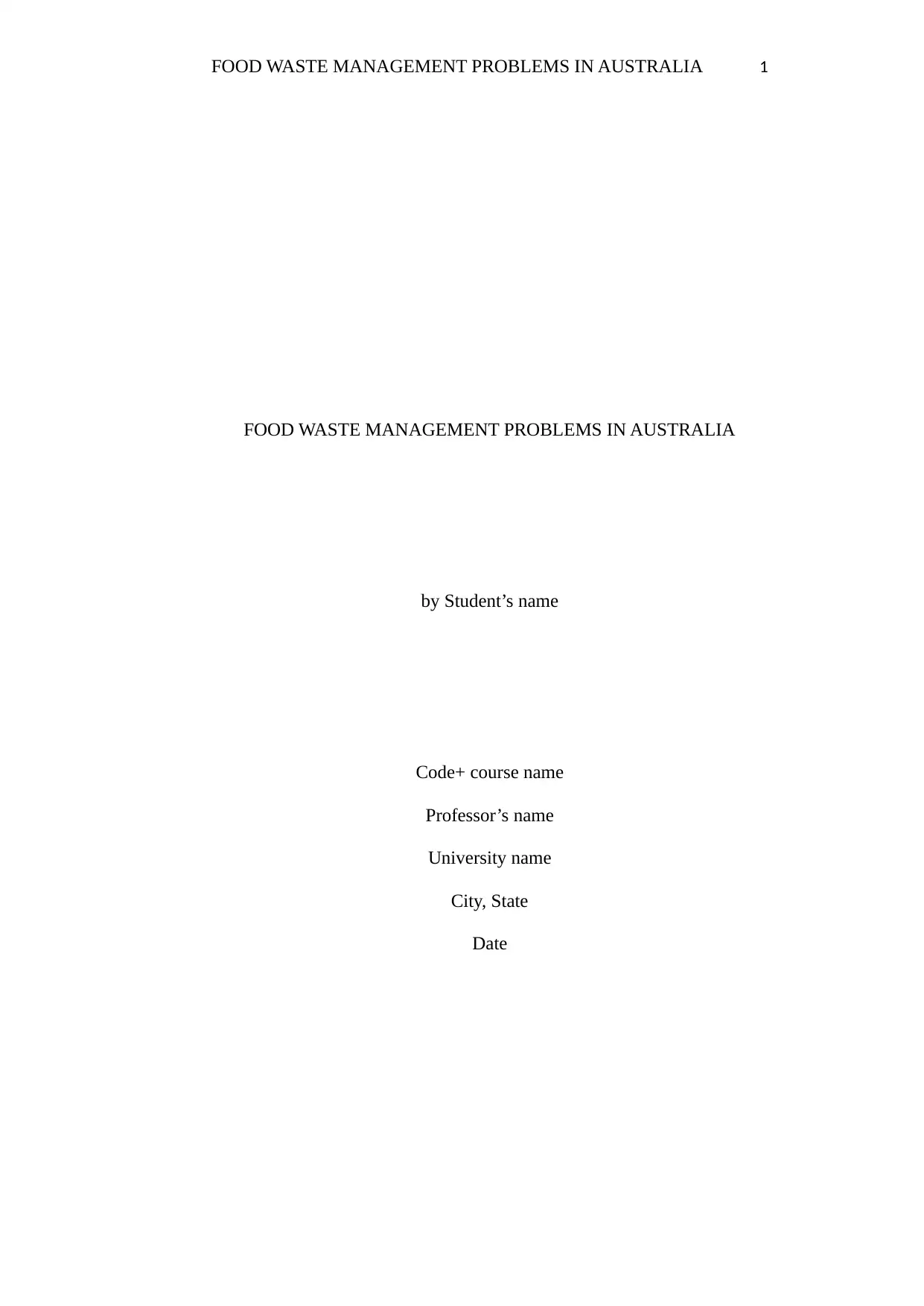
FOOD WASTE MANAGEMENT PROBLEMS IN AUSTRALIA 1
FOOD WASTE MANAGEMENT PROBLEMS IN AUSTRALIA
by Student’s name
Code+ course name
Professor’s name
University name
City, State
Date
FOOD WASTE MANAGEMENT PROBLEMS IN AUSTRALIA
by Student’s name
Code+ course name
Professor’s name
University name
City, State
Date
Paraphrase This Document
Need a fresh take? Get an instant paraphrase of this document with our AI Paraphraser
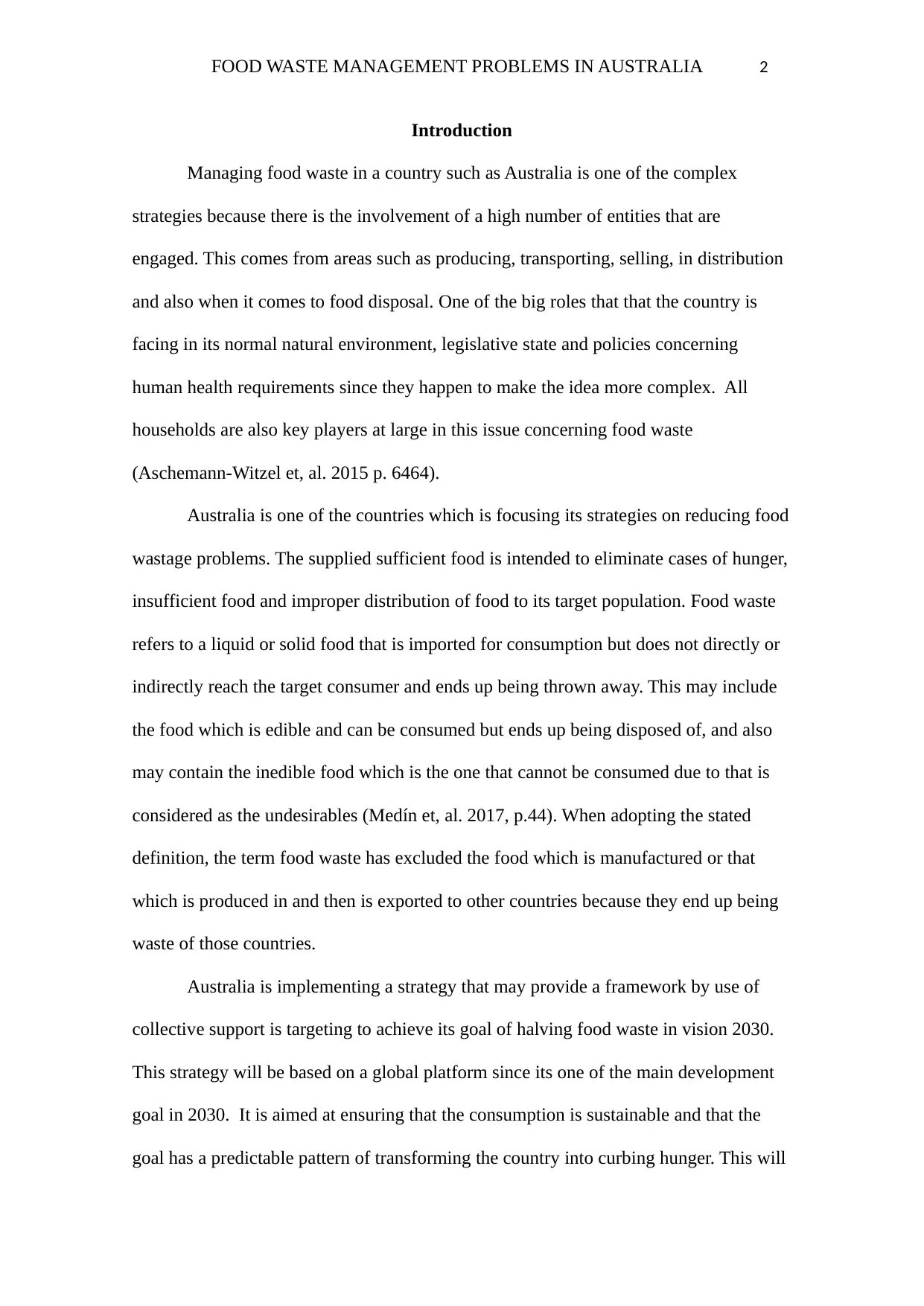
FOOD WASTE MANAGEMENT PROBLEMS IN AUSTRALIA 2
Introduction
Managing food waste in a country such as Australia is one of the complex
strategies because there is the involvement of a high number of entities that are
engaged. This comes from areas such as producing, transporting, selling, in distribution
and also when it comes to food disposal. One of the big roles that that the country is
facing in its normal natural environment, legislative state and policies concerning
human health requirements since they happen to make the idea more complex. All
households are also key players at large in this issue concerning food waste
(Aschemann-Witzel et, al. 2015 p. 6464).
Australia is one of the countries which is focusing its strategies on reducing food
wastage problems. The supplied sufficient food is intended to eliminate cases of hunger,
insufficient food and improper distribution of food to its target population. Food waste
refers to a liquid or solid food that is imported for consumption but does not directly or
indirectly reach the target consumer and ends up being thrown away. This may include
the food which is edible and can be consumed but ends up being disposed of, and also
may contain the inedible food which is the one that cannot be consumed due to that is
considered as the undesirables (Medín et, al. 2017, p.44). When adopting the stated
definition, the term food waste has excluded the food which is manufactured or that
which is produced in and then is exported to other countries because they end up being
waste of those countries.
Australia is implementing a strategy that may provide a framework by use of
collective support is targeting to achieve its goal of halving food waste in vision 2030.
This strategy will be based on a global platform since its one of the main development
goal in 2030. It is aimed at ensuring that the consumption is sustainable and that the
goal has a predictable pattern of transforming the country into curbing hunger. This will
Introduction
Managing food waste in a country such as Australia is one of the complex
strategies because there is the involvement of a high number of entities that are
engaged. This comes from areas such as producing, transporting, selling, in distribution
and also when it comes to food disposal. One of the big roles that that the country is
facing in its normal natural environment, legislative state and policies concerning
human health requirements since they happen to make the idea more complex. All
households are also key players at large in this issue concerning food waste
(Aschemann-Witzel et, al. 2015 p. 6464).
Australia is one of the countries which is focusing its strategies on reducing food
wastage problems. The supplied sufficient food is intended to eliminate cases of hunger,
insufficient food and improper distribution of food to its target population. Food waste
refers to a liquid or solid food that is imported for consumption but does not directly or
indirectly reach the target consumer and ends up being thrown away. This may include
the food which is edible and can be consumed but ends up being disposed of, and also
may contain the inedible food which is the one that cannot be consumed due to that is
considered as the undesirables (Medín et, al. 2017, p.44). When adopting the stated
definition, the term food waste has excluded the food which is manufactured or that
which is produced in and then is exported to other countries because they end up being
waste of those countries.
Australia is implementing a strategy that may provide a framework by use of
collective support is targeting to achieve its goal of halving food waste in vision 2030.
This strategy will be based on a global platform since its one of the main development
goal in 2030. It is aimed at ensuring that the consumption is sustainable and that the
goal has a predictable pattern of transforming the country into curbing hunger. This will
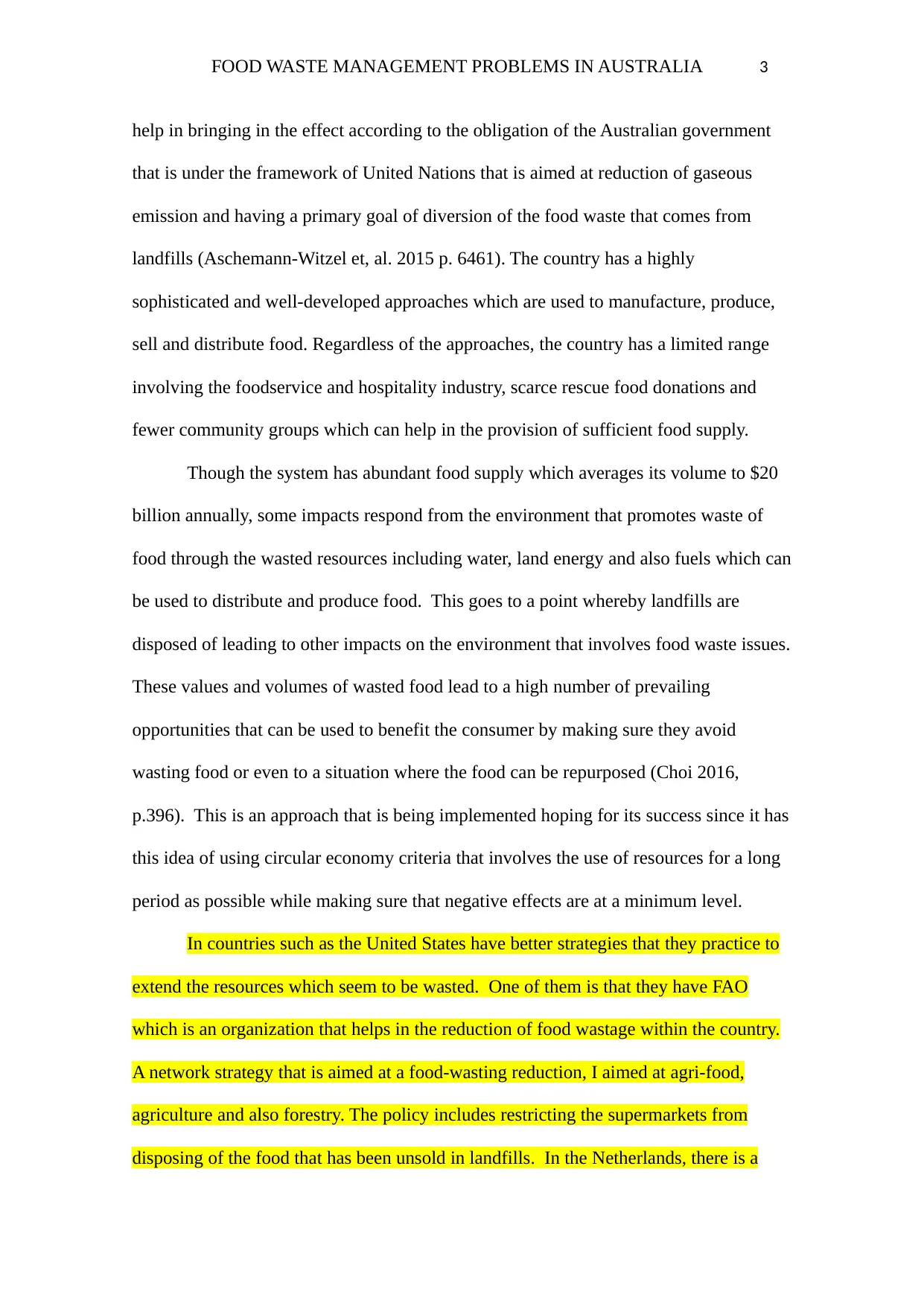
FOOD WASTE MANAGEMENT PROBLEMS IN AUSTRALIA 3
help in bringing in the effect according to the obligation of the Australian government
that is under the framework of United Nations that is aimed at reduction of gaseous
emission and having a primary goal of diversion of the food waste that comes from
landfills (Aschemann-Witzel et, al. 2015 p. 6461). The country has a highly
sophisticated and well-developed approaches which are used to manufacture, produce,
sell and distribute food. Regardless of the approaches, the country has a limited range
involving the foodservice and hospitality industry, scarce rescue food donations and
fewer community groups which can help in the provision of sufficient food supply.
Though the system has abundant food supply which averages its volume to $20
billion annually, some impacts respond from the environment that promotes waste of
food through the wasted resources including water, land energy and also fuels which can
be used to distribute and produce food. This goes to a point whereby landfills are
disposed of leading to other impacts on the environment that involves food waste issues.
These values and volumes of wasted food lead to a high number of prevailing
opportunities that can be used to benefit the consumer by making sure they avoid
wasting food or even to a situation where the food can be repurposed (Choi 2016,
p.396). This is an approach that is being implemented hoping for its success since it has
this idea of using circular economy criteria that involves the use of resources for a long
period as possible while making sure that negative effects are at a minimum level.
In countries such as the United States have better strategies that they practice to
extend the resources which seem to be wasted. One of them is that they have FAO
which is an organization that helps in the reduction of food wastage within the country.
A network strategy that is aimed at a food-wasting reduction, I aimed at agri-food,
agriculture and also forestry. The policy includes restricting the supermarkets from
disposing of the food that has been unsold in landfills. In the Netherlands, there is a
help in bringing in the effect according to the obligation of the Australian government
that is under the framework of United Nations that is aimed at reduction of gaseous
emission and having a primary goal of diversion of the food waste that comes from
landfills (Aschemann-Witzel et, al. 2015 p. 6461). The country has a highly
sophisticated and well-developed approaches which are used to manufacture, produce,
sell and distribute food. Regardless of the approaches, the country has a limited range
involving the foodservice and hospitality industry, scarce rescue food donations and
fewer community groups which can help in the provision of sufficient food supply.
Though the system has abundant food supply which averages its volume to $20
billion annually, some impacts respond from the environment that promotes waste of
food through the wasted resources including water, land energy and also fuels which can
be used to distribute and produce food. This goes to a point whereby landfills are
disposed of leading to other impacts on the environment that involves food waste issues.
These values and volumes of wasted food lead to a high number of prevailing
opportunities that can be used to benefit the consumer by making sure they avoid
wasting food or even to a situation where the food can be repurposed (Choi 2016,
p.396). This is an approach that is being implemented hoping for its success since it has
this idea of using circular economy criteria that involves the use of resources for a long
period as possible while making sure that negative effects are at a minimum level.
In countries such as the United States have better strategies that they practice to
extend the resources which seem to be wasted. One of them is that they have FAO
which is an organization that helps in the reduction of food wastage within the country.
A network strategy that is aimed at a food-wasting reduction, I aimed at agri-food,
agriculture and also forestry. The policy includes restricting the supermarkets from
disposing of the food that has been unsold in landfills. In the Netherlands, there is a
⊘ This is a preview!⊘
Do you want full access?
Subscribe today to unlock all pages.

Trusted by 1+ million students worldwide
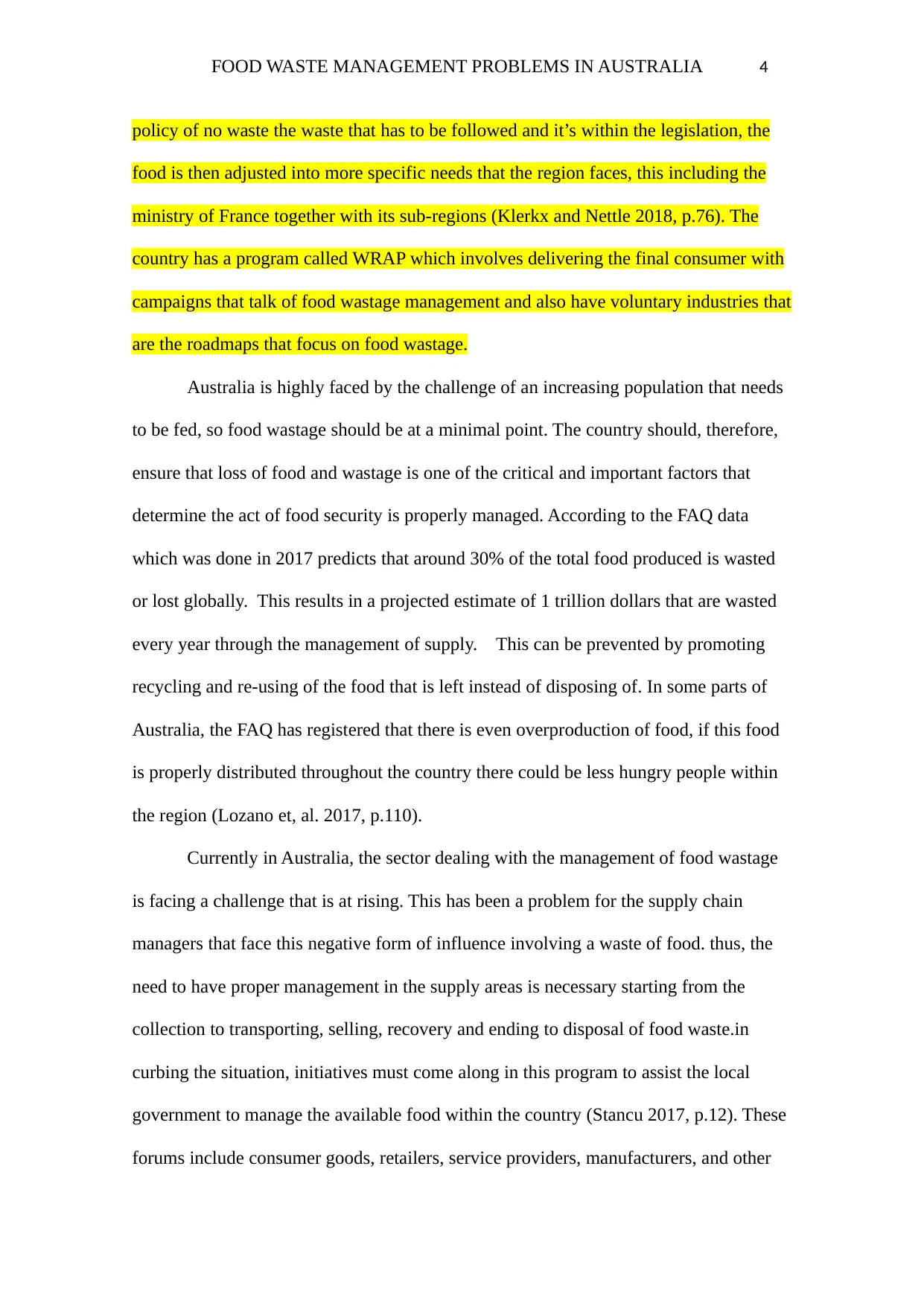
FOOD WASTE MANAGEMENT PROBLEMS IN AUSTRALIA 4
policy of no waste the waste that has to be followed and it’s within the legislation, the
food is then adjusted into more specific needs that the region faces, this including the
ministry of France together with its sub-regions (Klerkx and Nettle 2018, p.76). The
country has a program called WRAP which involves delivering the final consumer with
campaigns that talk of food wastage management and also have voluntary industries that
are the roadmaps that focus on food wastage.
Australia is highly faced by the challenge of an increasing population that needs
to be fed, so food wastage should be at a minimal point. The country should, therefore,
ensure that loss of food and wastage is one of the critical and important factors that
determine the act of food security is properly managed. According to the FAQ data
which was done in 2017 predicts that around 30% of the total food produced is wasted
or lost globally. This results in a projected estimate of 1 trillion dollars that are wasted
every year through the management of supply. This can be prevented by promoting
recycling and re-using of the food that is left instead of disposing of. In some parts of
Australia, the FAQ has registered that there is even overproduction of food, if this food
is properly distributed throughout the country there could be less hungry people within
the region (Lozano et, al. 2017, p.110).
Currently in Australia, the sector dealing with the management of food wastage
is facing a challenge that is at rising. This has been a problem for the supply chain
managers that face this negative form of influence involving a waste of food. thus, the
need to have proper management in the supply areas is necessary starting from the
collection to transporting, selling, recovery and ending to disposal of food waste.in
curbing the situation, initiatives must come along in this program to assist the local
government to manage the available food within the country (Stancu 2017, p.12). These
forums include consumer goods, retailers, service providers, manufacturers, and other
policy of no waste the waste that has to be followed and it’s within the legislation, the
food is then adjusted into more specific needs that the region faces, this including the
ministry of France together with its sub-regions (Klerkx and Nettle 2018, p.76). The
country has a program called WRAP which involves delivering the final consumer with
campaigns that talk of food wastage management and also have voluntary industries that
are the roadmaps that focus on food wastage.
Australia is highly faced by the challenge of an increasing population that needs
to be fed, so food wastage should be at a minimal point. The country should, therefore,
ensure that loss of food and wastage is one of the critical and important factors that
determine the act of food security is properly managed. According to the FAQ data
which was done in 2017 predicts that around 30% of the total food produced is wasted
or lost globally. This results in a projected estimate of 1 trillion dollars that are wasted
every year through the management of supply. This can be prevented by promoting
recycling and re-using of the food that is left instead of disposing of. In some parts of
Australia, the FAQ has registered that there is even overproduction of food, if this food
is properly distributed throughout the country there could be less hungry people within
the region (Lozano et, al. 2017, p.110).
Currently in Australia, the sector dealing with the management of food wastage
is facing a challenge that is at rising. This has been a problem for the supply chain
managers that face this negative form of influence involving a waste of food. thus, the
need to have proper management in the supply areas is necessary starting from the
collection to transporting, selling, recovery and ending to disposal of food waste.in
curbing the situation, initiatives must come along in this program to assist the local
government to manage the available food within the country (Stancu 2017, p.12). These
forums include consumer goods, retailers, service providers, manufacturers, and other
Paraphrase This Document
Need a fresh take? Get an instant paraphrase of this document with our AI Paraphraser
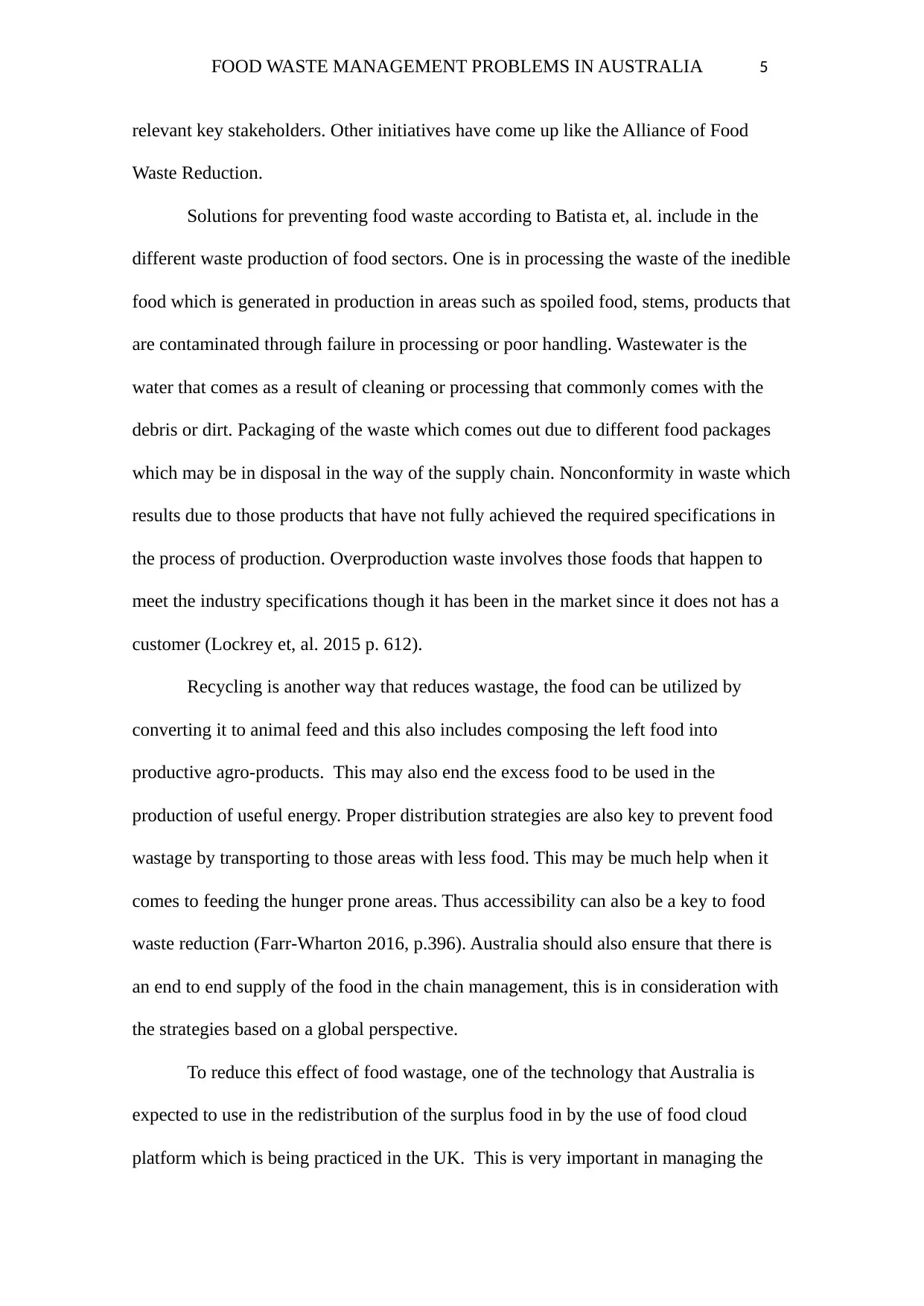
FOOD WASTE MANAGEMENT PROBLEMS IN AUSTRALIA 5
relevant key stakeholders. Other initiatives have come up like the Alliance of Food
Waste Reduction.
Solutions for preventing food waste according to Batista et, al. include in the
different waste production of food sectors. One is in processing the waste of the inedible
food which is generated in production in areas such as spoiled food, stems, products that
are contaminated through failure in processing or poor handling. Wastewater is the
water that comes as a result of cleaning or processing that commonly comes with the
debris or dirt. Packaging of the waste which comes out due to different food packages
which may be in disposal in the way of the supply chain. Nonconformity in waste which
results due to those products that have not fully achieved the required specifications in
the process of production. Overproduction waste involves those foods that happen to
meet the industry specifications though it has been in the market since it does not has a
customer (Lockrey et, al. 2015 p. 612).
Recycling is another way that reduces wastage, the food can be utilized by
converting it to animal feed and this also includes composing the left food into
productive agro-products. This may also end the excess food to be used in the
production of useful energy. Proper distribution strategies are also key to prevent food
wastage by transporting to those areas with less food. This may be much help when it
comes to feeding the hunger prone areas. Thus accessibility can also be a key to food
waste reduction (Farr‐Wharton 2016, p.396). Australia should also ensure that there is
an end to end supply of the food in the chain management, this is in consideration with
the strategies based on a global perspective.
To reduce this effect of food wastage, one of the technology that Australia is
expected to use in the redistribution of the surplus food in by the use of food cloud
platform which is being practiced in the UK. This is very important in managing the
relevant key stakeholders. Other initiatives have come up like the Alliance of Food
Waste Reduction.
Solutions for preventing food waste according to Batista et, al. include in the
different waste production of food sectors. One is in processing the waste of the inedible
food which is generated in production in areas such as spoiled food, stems, products that
are contaminated through failure in processing or poor handling. Wastewater is the
water that comes as a result of cleaning or processing that commonly comes with the
debris or dirt. Packaging of the waste which comes out due to different food packages
which may be in disposal in the way of the supply chain. Nonconformity in waste which
results due to those products that have not fully achieved the required specifications in
the process of production. Overproduction waste involves those foods that happen to
meet the industry specifications though it has been in the market since it does not has a
customer (Lockrey et, al. 2015 p. 612).
Recycling is another way that reduces wastage, the food can be utilized by
converting it to animal feed and this also includes composing the left food into
productive agro-products. This may also end the excess food to be used in the
production of useful energy. Proper distribution strategies are also key to prevent food
wastage by transporting to those areas with less food. This may be much help when it
comes to feeding the hunger prone areas. Thus accessibility can also be a key to food
waste reduction (Farr‐Wharton 2016, p.396). Australia should also ensure that there is
an end to end supply of the food in the chain management, this is in consideration with
the strategies based on a global perspective.
To reduce this effect of food wastage, one of the technology that Australia is
expected to use in the redistribution of the surplus food in by the use of food cloud
platform which is being practiced in the UK. This is very important in managing the
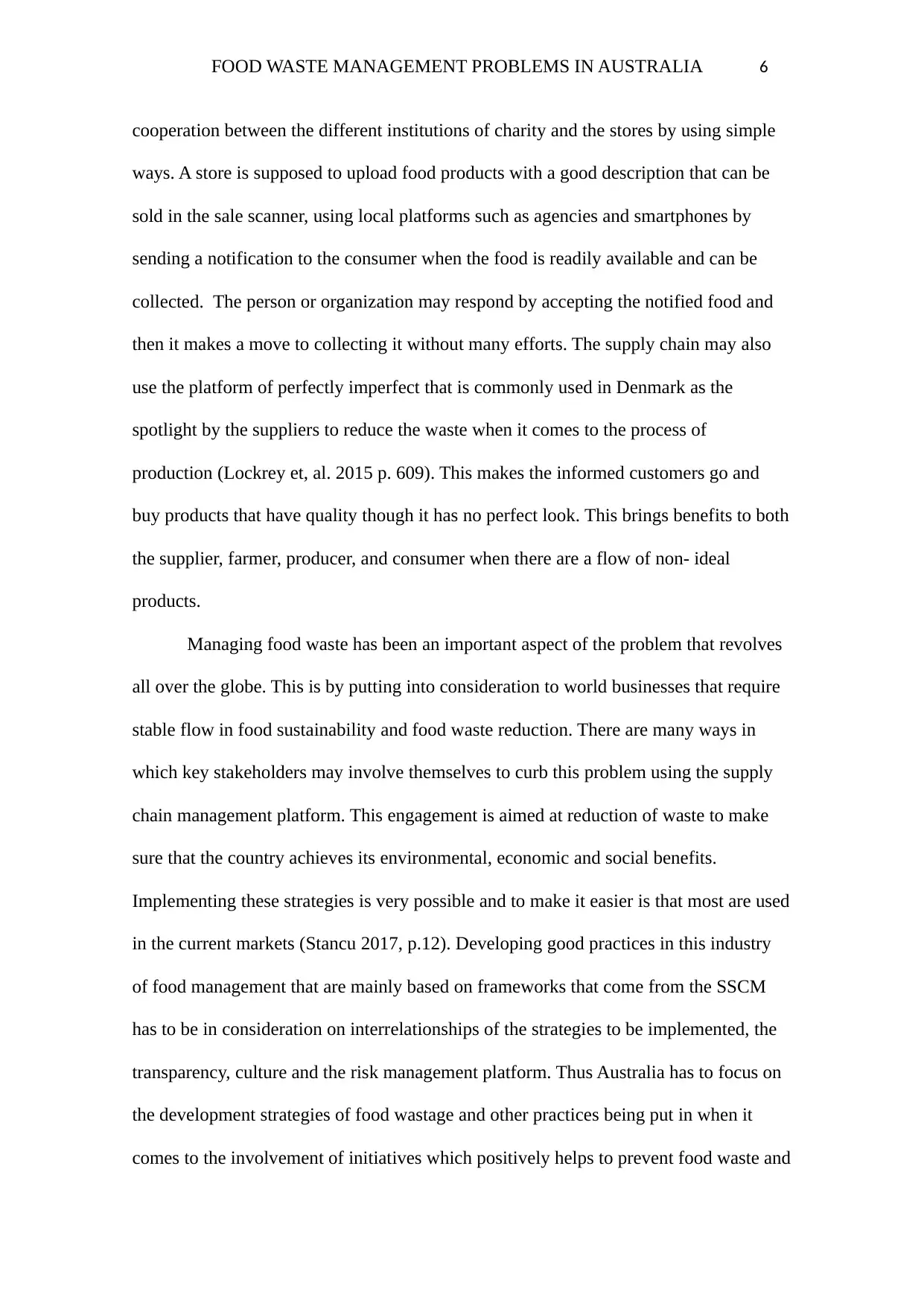
FOOD WASTE MANAGEMENT PROBLEMS IN AUSTRALIA 6
cooperation between the different institutions of charity and the stores by using simple
ways. A store is supposed to upload food products with a good description that can be
sold in the sale scanner, using local platforms such as agencies and smartphones by
sending a notification to the consumer when the food is readily available and can be
collected. The person or organization may respond by accepting the notified food and
then it makes a move to collecting it without many efforts. The supply chain may also
use the platform of perfectly imperfect that is commonly used in Denmark as the
spotlight by the suppliers to reduce the waste when it comes to the process of
production (Lockrey et, al. 2015 p. 609). This makes the informed customers go and
buy products that have quality though it has no perfect look. This brings benefits to both
the supplier, farmer, producer, and consumer when there are a flow of non- ideal
products.
Managing food waste has been an important aspect of the problem that revolves
all over the globe. This is by putting into consideration to world businesses that require
stable flow in food sustainability and food waste reduction. There are many ways in
which key stakeholders may involve themselves to curb this problem using the supply
chain management platform. This engagement is aimed at reduction of waste to make
sure that the country achieves its environmental, economic and social benefits.
Implementing these strategies is very possible and to make it easier is that most are used
in the current markets (Stancu 2017, p.12). Developing good practices in this industry
of food management that are mainly based on frameworks that come from the SSCM
has to be in consideration on interrelationships of the strategies to be implemented, the
transparency, culture and the risk management platform. Thus Australia has to focus on
the development strategies of food wastage and other practices being put in when it
comes to the involvement of initiatives which positively helps to prevent food waste and
cooperation between the different institutions of charity and the stores by using simple
ways. A store is supposed to upload food products with a good description that can be
sold in the sale scanner, using local platforms such as agencies and smartphones by
sending a notification to the consumer when the food is readily available and can be
collected. The person or organization may respond by accepting the notified food and
then it makes a move to collecting it without many efforts. The supply chain may also
use the platform of perfectly imperfect that is commonly used in Denmark as the
spotlight by the suppliers to reduce the waste when it comes to the process of
production (Lockrey et, al. 2015 p. 609). This makes the informed customers go and
buy products that have quality though it has no perfect look. This brings benefits to both
the supplier, farmer, producer, and consumer when there are a flow of non- ideal
products.
Managing food waste has been an important aspect of the problem that revolves
all over the globe. This is by putting into consideration to world businesses that require
stable flow in food sustainability and food waste reduction. There are many ways in
which key stakeholders may involve themselves to curb this problem using the supply
chain management platform. This engagement is aimed at reduction of waste to make
sure that the country achieves its environmental, economic and social benefits.
Implementing these strategies is very possible and to make it easier is that most are used
in the current markets (Stancu 2017, p.12). Developing good practices in this industry
of food management that are mainly based on frameworks that come from the SSCM
has to be in consideration on interrelationships of the strategies to be implemented, the
transparency, culture and the risk management platform. Thus Australia has to focus on
the development strategies of food wastage and other practices being put in when it
comes to the involvement of initiatives which positively helps to prevent food waste and
⊘ This is a preview!⊘
Do you want full access?
Subscribe today to unlock all pages.

Trusted by 1+ million students worldwide
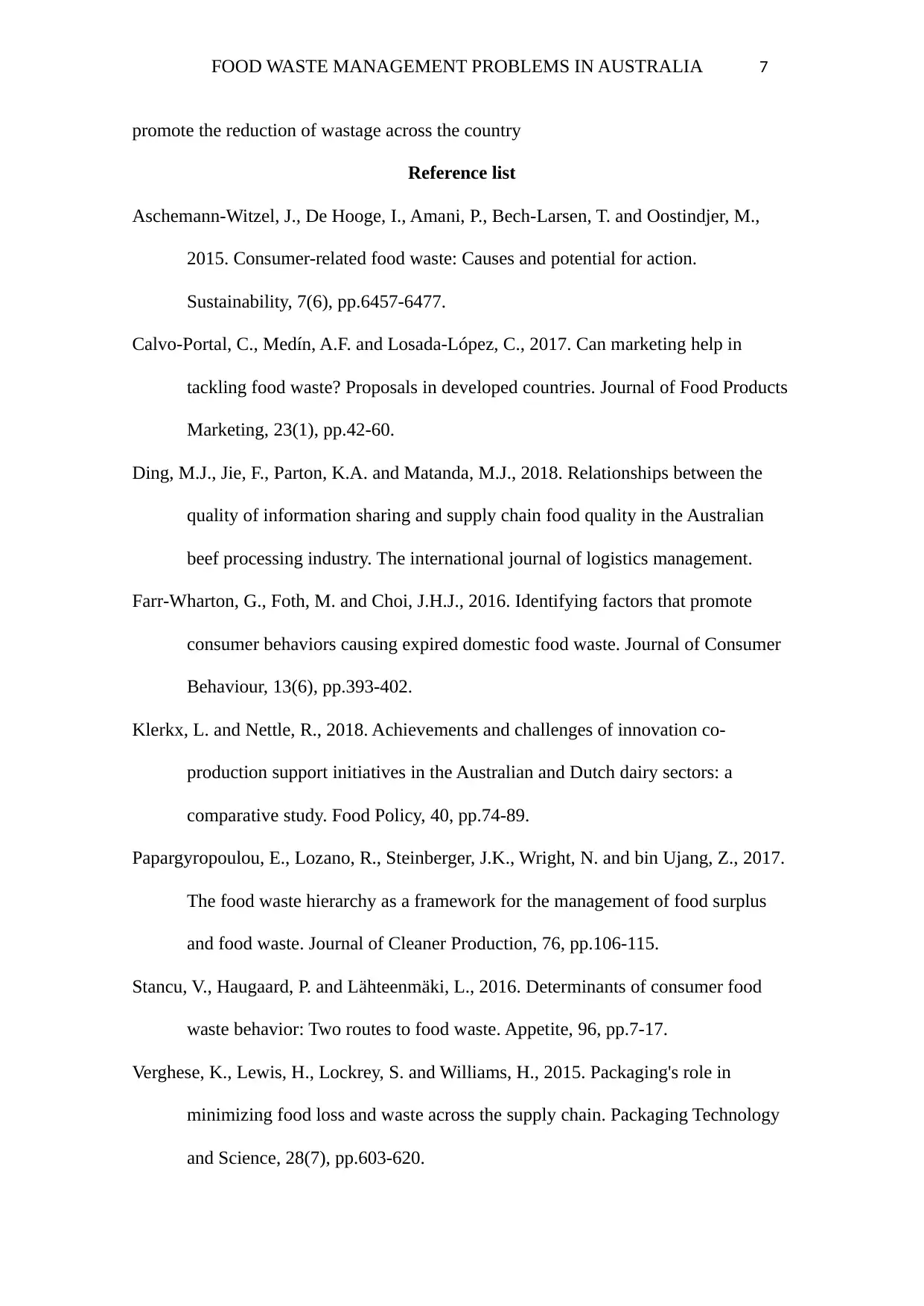
FOOD WASTE MANAGEMENT PROBLEMS IN AUSTRALIA 7
promote the reduction of wastage across the country
Reference list
Aschemann-Witzel, J., De Hooge, I., Amani, P., Bech-Larsen, T. and Oostindjer, M.,
2015. Consumer-related food waste: Causes and potential for action.
Sustainability, 7(6), pp.6457-6477.
Calvo-Portal, C., Medín, A.F. and Losada-López, C., 2017. Can marketing help in
tackling food waste? Proposals in developed countries. Journal of Food Products
Marketing, 23(1), pp.42-60.
Ding, M.J., Jie, F., Parton, K.A. and Matanda, M.J., 2018. Relationships between the
quality of information sharing and supply chain food quality in the Australian
beef processing industry. The international journal of logistics management.
Farr‐Wharton, G., Foth, M. and Choi, J.H.J., 2016. Identifying factors that promote
consumer behaviors causing expired domestic food waste. Journal of Consumer
Behaviour, 13(6), pp.393-402.
Klerkx, L. and Nettle, R., 2018. Achievements and challenges of innovation co-
production support initiatives in the Australian and Dutch dairy sectors: a
comparative study. Food Policy, 40, pp.74-89.
Papargyropoulou, E., Lozano, R., Steinberger, J.K., Wright, N. and bin Ujang, Z., 2017.
The food waste hierarchy as a framework for the management of food surplus
and food waste. Journal of Cleaner Production, 76, pp.106-115.
Stancu, V., Haugaard, P. and Lähteenmäki, L., 2016. Determinants of consumer food
waste behavior: Two routes to food waste. Appetite, 96, pp.7-17.
Verghese, K., Lewis, H., Lockrey, S. and Williams, H., 2015. Packaging's role in
minimizing food loss and waste across the supply chain. Packaging Technology
and Science, 28(7), pp.603-620.
promote the reduction of wastage across the country
Reference list
Aschemann-Witzel, J., De Hooge, I., Amani, P., Bech-Larsen, T. and Oostindjer, M.,
2015. Consumer-related food waste: Causes and potential for action.
Sustainability, 7(6), pp.6457-6477.
Calvo-Portal, C., Medín, A.F. and Losada-López, C., 2017. Can marketing help in
tackling food waste? Proposals in developed countries. Journal of Food Products
Marketing, 23(1), pp.42-60.
Ding, M.J., Jie, F., Parton, K.A. and Matanda, M.J., 2018. Relationships between the
quality of information sharing and supply chain food quality in the Australian
beef processing industry. The international journal of logistics management.
Farr‐Wharton, G., Foth, M. and Choi, J.H.J., 2016. Identifying factors that promote
consumer behaviors causing expired domestic food waste. Journal of Consumer
Behaviour, 13(6), pp.393-402.
Klerkx, L. and Nettle, R., 2018. Achievements and challenges of innovation co-
production support initiatives in the Australian and Dutch dairy sectors: a
comparative study. Food Policy, 40, pp.74-89.
Papargyropoulou, E., Lozano, R., Steinberger, J.K., Wright, N. and bin Ujang, Z., 2017.
The food waste hierarchy as a framework for the management of food surplus
and food waste. Journal of Cleaner Production, 76, pp.106-115.
Stancu, V., Haugaard, P. and Lähteenmäki, L., 2016. Determinants of consumer food
waste behavior: Two routes to food waste. Appetite, 96, pp.7-17.
Verghese, K., Lewis, H., Lockrey, S. and Williams, H., 2015. Packaging's role in
minimizing food loss and waste across the supply chain. Packaging Technology
and Science, 28(7), pp.603-620.
1 out of 7
Related Documents
Your All-in-One AI-Powered Toolkit for Academic Success.
+13062052269
info@desklib.com
Available 24*7 on WhatsApp / Email
![[object Object]](/_next/static/media/star-bottom.7253800d.svg)
Unlock your academic potential
Copyright © 2020–2025 A2Z Services. All Rights Reserved. Developed and managed by ZUCOL.





